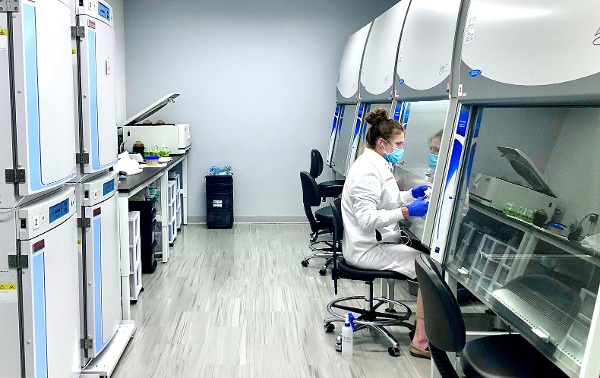Applying to an incubator is a mix between applying for a lease and interviewing for a job.
Southern California is in a phase where finding wet lab space for startups is becoming easier over time. More and more wet lab incubators are opening all over the region. So, a startup acquiring wet lab space should be as simple as finding an incubator and paying for it, right? Not necessarily—incubators often have competitive application processes for selecting startups even if they are not full. Applying to an incubator is a mix between applying for a lease and interviewing for a job. Both sides have to agree that the company is a good fit for the incubator.
There are many reasons for this selection process, including the open and collaborative nature of many incubators. These are not just chunks of real estate, they are actively managed communities. As anyone who has had a bad neighbor can attest, the people within a community can make or break the experience for other members. Plus, incubators aim to produce successful companies from their spaces, which necessitates picking those that have a high potential for success from the beginning.
As in all things, preparation is key. There is a wide variety of incubators with differing practices in Southern California, but in general they create pick startups that align with specific goals. Startups that understand the most common criteria and processes ahead of time have an advantage, so read on to learn what to expect when applying to a wet lab incubator.
🔬 Read more about: Lab Space for Biotech Startups.
The first step in applying to an incubator is not filling out the application, although it may be readily available online. The first step is connecting with the incubator staff. They can provide important information that will tell an entrepreneur whether they are a good fit. For example, talking to incubator staff can reveal whether they have capacity in the scientific areas a company needs. The website may list biosafety cabinets as shared equipment, but if a company needs a dedicated unit for eight-plus hours per day, one must talk to the incubator staff to determine if that’s feasible.
Besides allowing a startup to ask specific questions, contacting the incubator staff provides an opportunity for a good first impression. Some of the staff may be involved in evaluating applications, so if they have met and liked an applicant, that startup may have a better chance of success. Ways to make a good first impression include:
During these first conversations the startup should also be discerning of whether the incubator seems to be well-run and a good fit. The startup can be on the lookout for the following in their initial communications:

The next step in applying to an incubator still does not involve the application. After determining that the incubator and its staff seem to be good fits for the startup, the next step is examining the space itself. To do this, do not just show up at the incubator. Book a tour, either by email or a link for booking tours on the website if there is one. This ensures that there will be a staff member available to conduct the tour when the startup arrives and answer any questions they may have.
During the tour, the startup has a chance to ask questions about the facility and daily operations of the incubator. Here are some helpful questions to ask during a tour:
Besides asking questions, startups should also keep an eye out during the tour for things like:
🔬 Related: 5 Must Ask Questions for Wet Lab Incubators
Now it’s finally time to fill out the application. Well, to prepare to fill out the application, at least. There are a number of pieces of information that a startup will want to have organized and ready beforehand. Here is a list of information that many incubators will want to know as part of the application:
This information will cover the majority of what most incubator applications will ask and will also be useful for a startup to have when they apply for funding.
On the application itself, take care to be thorough and avoid grammatical errors—especially those that make it difficult to understand the content. If those reviewing the application have to work too hard to understand the application, it is more likely to be put in the reject pile. Incubators may have a variety of people reviewing the applications, which can include scientists, investors, entrepreneurs, and others. Therefore, the writing should be at a level which most adults can understand, while leaving an impression of credibility.
Be aware that some incubators accept applications at any time, while others have periodic reviews. This can greatly affect a startup’s timeline.

The interview portion of the application process is by far the most important. This is the point when the decision makers interact directly with the startup, and when both the incubator and the applicant have already invested significant time in the process.
In preparation for the interview, the startup should make sure that their decision maker and at least one person that will work on-site at the incubator are going to attend. If the interview is on-site, make sure to be on time. If it is virtual, make sure that those who are attending will have a quiet space from which to participate using their webcam. It is disruptive to the interview if one person is attending from a cell phone while driving, for instance.
The interview participants can prepare questions about the incubator beforehand. Besides answering real questions the startup has, these inquiries can be opportunities to emphasize the characteristics the incubator values without bragging. For example, if the incubator staff have made it clear that collaboration is important to them, a startup could ask whether there are events where members can get to know one another.
Commonly, the interview will be conducted by a panel that may consist of incubator staff, advisors, and/or board members. They will generally have looked over the application beforehand and have questions ready. Some incubators will ask the startup to explain what their company does during the interview so everyone is on the same page. Regardless, it is always good practice to avoid making the audience feel stupid (as stated in a previous post), so repetition of cogent points is appropriate even if they are already in the application materials.
Because the interview panel may have a number of questions they need to get through before the end of the interview, the startup should take care not to monopolize the time allotted. It’s great to see an entrepreneur who is excited about their technology, but that can become wearing for the interview panel if thirty minutes in, they are still on the first question.
For many incubators, selecting their member companies means not just bringing in excellent startups, but making sure those startups will not disrupt the existing community. In the interview, some incubators will look to determine how likely a startup is to fit in well with their standard of behavior. A startup that understands an incubator is a shared space and wants to interact with other members is likely to be viewed well in this regard. In contrast, a startup that seems to seek preferential treatment and solitude may give the impression of being difficult.
The interview is a two-way interaction. This is also an opportunity for the startup to solidify whether the incubator is a good fit for them. The incubator staff will be like coworkers, so the startup should be evaluating them if they are part of the interview panel. The startup can also continue evaluating other aspects of the incubator. Examples of questions that a startup might wait until the interview to bring up include:
These questions are just examples as each startup will have had different conversations by this point with the incubator, but they are good for sparking more in-depth conversation. They demonstrate that the startup is thinking beyond just being accepted to the incubator—they are considering how they will use the space and become part of the community.
🔬 Learn more about: What is Life Like at a Wet Lab Incubator?
If the timeline for the application process is not posted on the incubator’s website, it will likely have been communicated in an email. If not, then feel free to ask when to expect a response. Then, don’t ask about the decision again until after that date.
Upon being accepted to the incubator, the startup may choose to move forward or not. If the startup decides that the incubator isn’t the right place for them, they should still take care to be gracious. Many entrepreneurs go on to start multiple companies, so they might end up at this incubator one day, just with a different startup.
If both parties agree though, it’s on to onboarding!
Download The Ultimate Guide to Wet Lab Incubators in Southern California, a handbook to assist life science start-ups through the entire decision-making process to find wet lab space.
Download Now